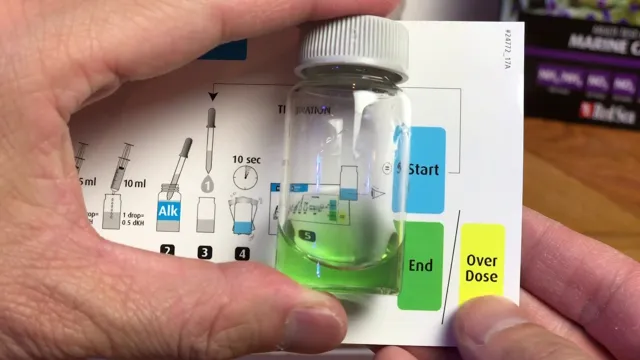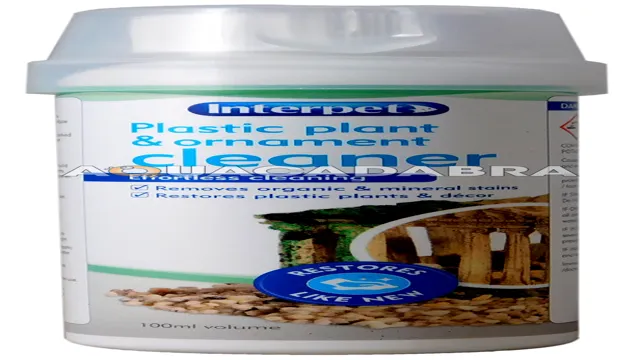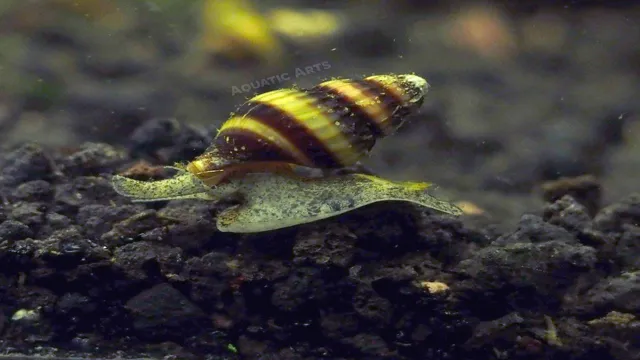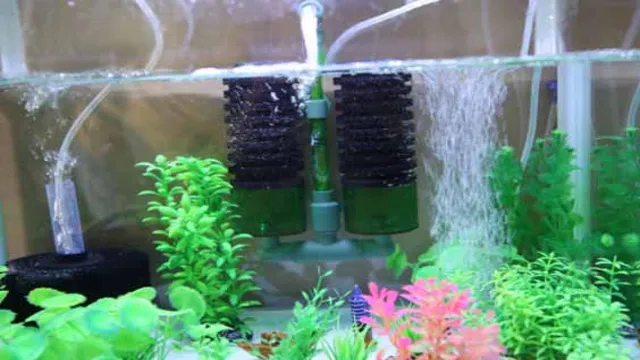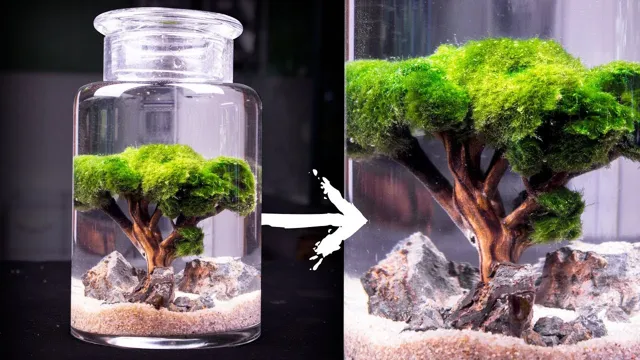If you own a saltwater aquarium, you know that maintaining a proper balance of water parameters is crucial for the health of your aquatic pets. But one important factor that is often overlooked by hobbyists is the alkalinity level of the water. Alkalinity is the measure of the water’s ability to neutralize acid, and it plays a vital role in keeping the pH level stable, which is essential for the survival of your fish, corals, and invertebrates.
In this blog post, we will explore the basics of alkalinity and why it is important to check it regularly in your saltwater aquarium. We will also provide you with some tips on how to maintain optimal alkalinity levels to ensure the long-term health and well-being of your marine creatures. So, let’s dive in!
What is alkalinity?
Alkalinity is a critical parameter to monitor in a saltwater aquarium. It refers to the amount of carbonate and bicarbonate ions present in the water. Maintaining the right alkalinity level ensures that the pH of the water remains stable.
This stability is vital because rapid fluctuations in pH can stress the aquarium’s inhabitants and even lead to their death. To check alkalinity levels in your saltwater aquarium, you can use a test kit specifically designed for this purpose. The test kit measures the amount of acids in the water, which react with the carbonate and bicarbonate ions.
The resulting color change indicates alkalinity levels. Aim to keep your alkalinity levels between 7 and 12 dKH (degrees of carbonate hardness) or 125 to 215 ppm (parts per million). Regular monitoring of alkalinity levels helps ensure a healthy and stable environment for your saltwater aquarium’s inhabitants.
Explanation of alkalinity and its importance in saltwater aquariums
Alkalinity is a critical parameter in saltwater aquariums that is often overlooked by many hobbyists. Simply put, it refers to the amount of carbonate and bicarbonate ions present in the water, which act as buffering agents and help to maintain a stable pH level. Low alkalinity levels can cause pH swings and ultimately lead to stress and even death of your fish and corals.
On the other hand, high alkalinity levels can hinder the growth of corals and even encourage the growth of nuisance algae. Maintaining proper alkalinity levels requires diligent monitoring and supplementation with alkaline additives such as baking soda or calcium carbonate. In short, ensuring adequate alkalinity in your saltwater aquarium is essential for the health and longevity of its inhabitants.
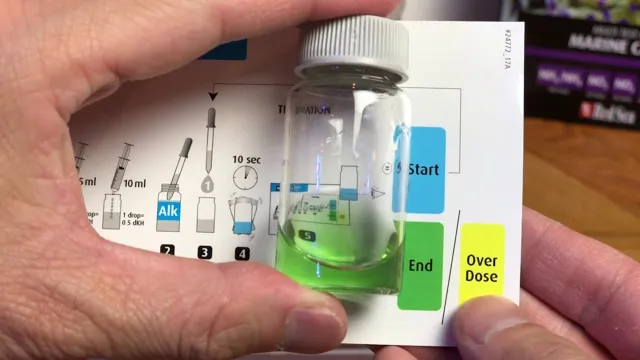
Tools for checking alkalinity
If you’re a saltwater aquarium owner, it’s important to regularly check the alkalinity of your tank. The easiest way to do this is with a test kit designed specifically for alkalinity. Test kits usually come with a color chart that allows you to match the color of your water with the corresponding alkalinity level.
Another way to check alkalinity is with a digital meter that measures the electrical conductivity of your water. These meters can be more expensive, but they offer a more precise and accurate reading. Whatever method you choose, make sure to regularly check your tank’s alkalinity to maintain a healthy and stable environment for your aquatic pets.
The different methods and tools that can be used to check alkalinity
Alkalinity is an important parameter in water testing that can affect the health of aquatic animals and plants. There are various tools that can be used to check alkalinity, including test strips, colorimeters, and titration kits. Test strips are the most common tools used because they are affordable and easy to use.
However, they are not accurate as they do not distinguish between different types of alkalinity. Colorimeters are more accurate and precise as they measure the light absorbance of a sample, but they can be costly and require regular calibration. Titration kits are the most accurate and reliable method for testing alkalinity as they measure the amount of acid needed to neutralize the alkalinity in a sample.
However, they require more time, skill, and preparation than other tools. Ultimately, the choice of which tool to use depends on the specific needs of the tester. It’s worth noting that high alkalinity can cause detrimental effects on aquatic life, but maintaining a balance of alkalinity and other parameters is crucial for preserving a healthy aquatic environment. (See Also: How to Go to Sea Aquarium Singapore: A Comprehensive Guide for Tourists)
Step-by-step guide to checking alkalinity
If you’re a saltwater aquarium owner, it’s essential to regularly check the alkalinity of your aquarium water. An incorrect level of alkalinity can lead to pH imbalances and harm your fish and other marine life. Here’s a step-by-step guide to checking alkalinity in your aquarium.
First, gather the necessary equipment, including a test kit, sample tube, and color chart. Next, take a sample of your aquarium water and add it to the test tube. Add the appropriate drops of the test reagent and mix well.
The water in the test tube will change color, and you’ll compare it to the color chart to determine the alkalinity level. Once you know the level, you can adjust it as needed with a water treatment or by adding alkaline substances like baking soda or an alkalinity buffer. By regularly checking the alkalinity of your saltwater aquarium, you’ll keep your marine life healthy and thriving.
Detailed instructions on how to conduct an alkalinity test
If you’re a pool owner, checking the alkalinity level of your pool water is essential for maintaining proper pH levels. Alkalinity refers to the water’s ability to resist changes in pH, and it should be kept between 80 to 120 parts per million (ppm). To conduct an alkalinity test, you will need a testing kit that measures alkalinity levels, which can be purchased from any pool supply store.
Firstly, take the water sample from a depth of 18 inches and immerse the test strip in the water. Wait for the recommended time for the strip to change its colour. Then, compare the colour of the strip to the provided chart to determine the alkalinity levels in your pool.
If the pool’s alkalinity levels are lower than recommended, add baking soda to the water to increase the alkalinity levels. On the other hand, if the pool’s alkalinity levels are higher than recommended, add muriatic acid to the water to decrease the levels. By following these simple steps, you can ensure that your pool water maintains proper alkalinity levels, which is crucial for ensuring a safe and enjoyable swimming experience.
Interpreting the results
When it comes to maintaining a healthy saltwater aquarium, checking the alkalinity is crucial. So how do you do it? Well, first you will need a reliable test kit specifically designed for testing alkalinity levels in saltwater. Next, follow the instructions carefully to ensure accurate results.
Once you have your test results, it’s time to interpret them. The ideal range for alkalinity in a saltwater aquarium is typically between 8-12 dKH (degrees of carbonate hardness). If your test results fall outside of this range, adjustments will need to be made.
Increasing alkalinity typically involves adding baking soda or a specialized buffer, while decreasing involves diluting the water or adding a pH reducer. It’s important to note that sudden changes in alkalinity can be harmful to fish and other aquarium inhabitants, so make changes slowly and monitor closely. Regular testing and maintenance will ensure a healthy and thriving saltwater aquarium for years to come.
Explanation of what the test results mean and how to interpret them
Interpreting the results of any test can seem overwhelming, but it doesn’t have to be. When analyzing the results, the first step is to determine what the scores represent and what range is considered typical. Understanding the score’s significance can help identify strengths and weaknesses in a particular area, and this insight can be used to make necessary improvements.
It’s also essential to be aware of the test’s limitations, such as false positives and negatives. For instance, a single test result may not accurately reflect an individual’s overall ability or performance. It’s crucial to review the results in the context of other available information to get a complete picture. (See Also: How to Make Aquarium More Alkaline: Tips and Tricks for Perfect pH Levels)
Remember, test results only provide one aspect of an individual’s abilities. Still, by using the insights gained from interpreting them, it’s possible to identify areas that need improvement and track progress over time.
Maintaining alkalinity levels
If you want to maintain a healthy saltwater aquarium, it’s important to keep the alkalinity levels in check. To do this, you’ll need to test the water regularly using either test strips or a test kit. The ideal alkalinity range for a saltwater aquarium is between 7 and 12 dKH.
If your levels are too low, you can raise them by adding a commercial alkalinity buffer to the tank. On the other hand, if your levels are too high, you can lower them by doing a partial water change. Keep in mind that if your alkalinity levels are too far out of range, it can cause stress and harm to your fish and other inhabitants.
By monitoring and adjusting alkalinity levels, you’ll be on your way to maintaining a healthy and thriving saltwater aquarium.
Tips and guidelines for keeping alkalinity levels balanced in the aquarium
Maintaining alkalinity levels is crucial for a healthy and thriving aquarium. Alkalinity, also known as carbonate hardness, refers to the level of bicarbonate and carbonate ions in the water. These ions act as a buffer, helping to maintain a stable pH level in the tank.
To keep the alkalinity levels balanced, it’s important to monitor them regularly using a reliable test kit. In general, an alkalinity level of 8-12 dKH is recommended for most aquariums. To increase alkalinity levels, you can add baking soda or a specialized alkalinity supplement to the water.
On the other hand, to decrease alkalinity levels, partial water changes or the use of specialized products like pH decreasers can be effective. However, it’s essential to make gradual changes to avoid shocking the aquarium’s inhabitants. By keeping a close eye on the alkalinity levels and making necessary adjustments, you can ensure a healthy environment for your aquatic pets.
Conclusion
In conclusion, checking the alkalinity in your saltwater aquarium is as important as remembering your anniversary – it’s a crucial element for the health and wellbeing of your aquatic pets. Using a simple test kit, you can ensure your aquarium has the perfect balance of alkalinity to keep your fish and corals happy and thriving. After all, just like in any good relationship, it’s the little things that count – and monitoring your aquarium’s alkalinity is one of those little things that can have a big impact.
“
Final thoughts on the importance of checking and maintaining alkalinity levels in saltwater aquariums
Maintaining alkalinity levels is an essential aspect of ensuring the health and longevity of saltwater aquariums. It is imperative to check the alkalinity levels regularly, as any fluctuations can have detrimental impacts on marine life. Alkalinity refers to the ability of water to neutralize acids, and in the case of saltwater aquariums, this is crucial for the survival of coral and other delicate creatures.
If alkalinity levels fall too low, it can lead to a drop in pH levels, which in turn can cause coral bleaching and the death of marine life. On the other hand, high alkalinity levels can lead to the precipitation of minerals, causing the water to become cloudy. Maintaining the correct alkalinity levels can be achieved through the addition of supplements and regular water changes. (See Also: How to Clean a Planted Freshwater Aquarium: A Step-by-Step Guide for Pristine Tanks)
It’s essential to remember that alkalinity levels are interlinked with other water parameters, such as calcium and magnesium levels. By maintaining the correct alkalinity levels, saltwater aquarium enthusiasts can enjoy healthy and thriving marine environments.
FAQs
What is alkalinity in saltwater aquariums?
Alkalinity is the measure of the water’s ability to resist a drop in pH levels. It is important to maintain stable alkalinity levels in order to provide a healthy environment for your aquatic organisms.
Why is it important to check alkalinity in saltwater aquariums?
Checking alkalinity levels is essential in maintaining the pH balance of your tank. Fluctuations in alkalinity levels can cause stress and even death to your aquatic organisms.
What is the ideal alkalinity range for a saltwater aquarium?
The ideal alkalinity range for a saltwater aquarium is between 7-12 dKH (degree carbonate hardness).
How can I test the alkalinity level of my saltwater aquarium?
You can test the alkalinity level of your saltwater aquarium by using a test kit specifically designed for measuring alkalinity.
What are some factors that can affect the alkalinity level of my saltwater aquarium?
Some factors that can affect the alkalinity level of your saltwater aquarium include: water changes, addition of new organisms, pH fluctuations, and alkalinity supplements.
What should I do if the alkalinity level of my saltwater aquarium is too low?
If the alkalinity level of your saltwater aquarium is too low, you can add an alkalinity supplement to raise the level. It is important to follow the manufacturer’s instructions and not add too much, as this can also be harmful.
Can high alkalinity levels be harmful to my saltwater aquarium?
Yes, high alkalinity levels can be harmful as it can lead to pH fluctuations and affect the acid-base balance of your tank. It is important to maintain stable alkalinity levels within the ideal range for a healthy saltwater aquarium.

